HI5017 Managerial Accounting Budgeting Report, University Study
VerifiedAdded on 2023/06/04
|19
|4106
|156
Report
AI Summary
This report provides an in-depth analysis of budgeting within the context of managerial accounting. It begins with an executive summary and table of contents, followed by an introduction that defines budgeting and its pervasive use across various sectors. The report details the advantages of budgeting, such as improved cash flow management, financial planning, and cost control, as well as the disadvantages, including reliance on assumptions, time consumption, and potential for friction between departments. The core of the report involves a discussion of two selected journals: one exploring the continued use of cash-based budgeting in the public sector, and another focusing on the benefits of a marketing budgeting model. The analysis covers the purpose of the studies, research questions, similarities and differences in findings, and specific outcomes, providing relevant learnings from the research. Overall, the report offers a comprehensive overview of budgeting, its practical applications, and its critical evaluation within the field of managerial accounting.
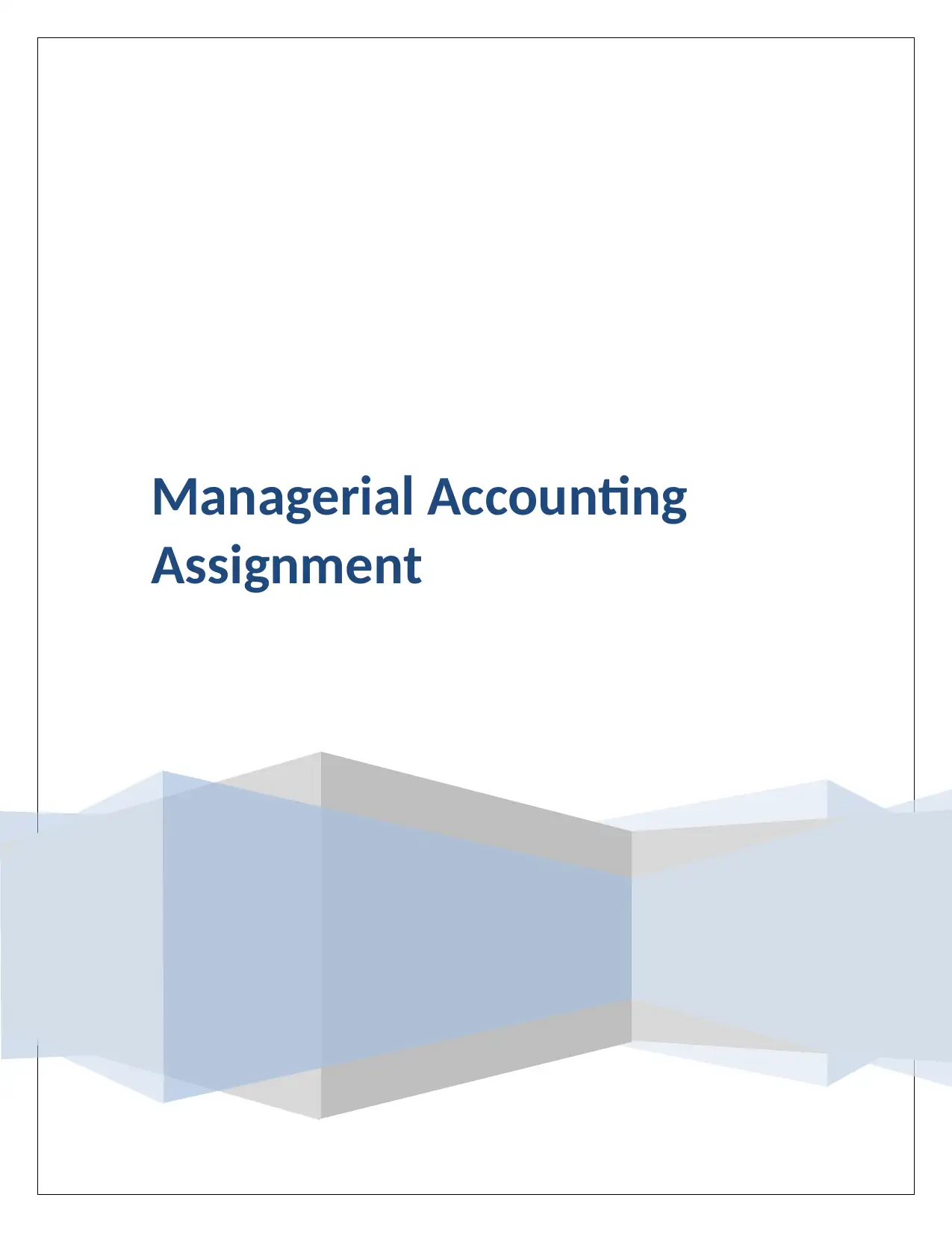
Managerial Accounting
Assignment
Assignment
Paraphrase This Document
Need a fresh take? Get an instant paraphrase of this document with our AI Paraphraser
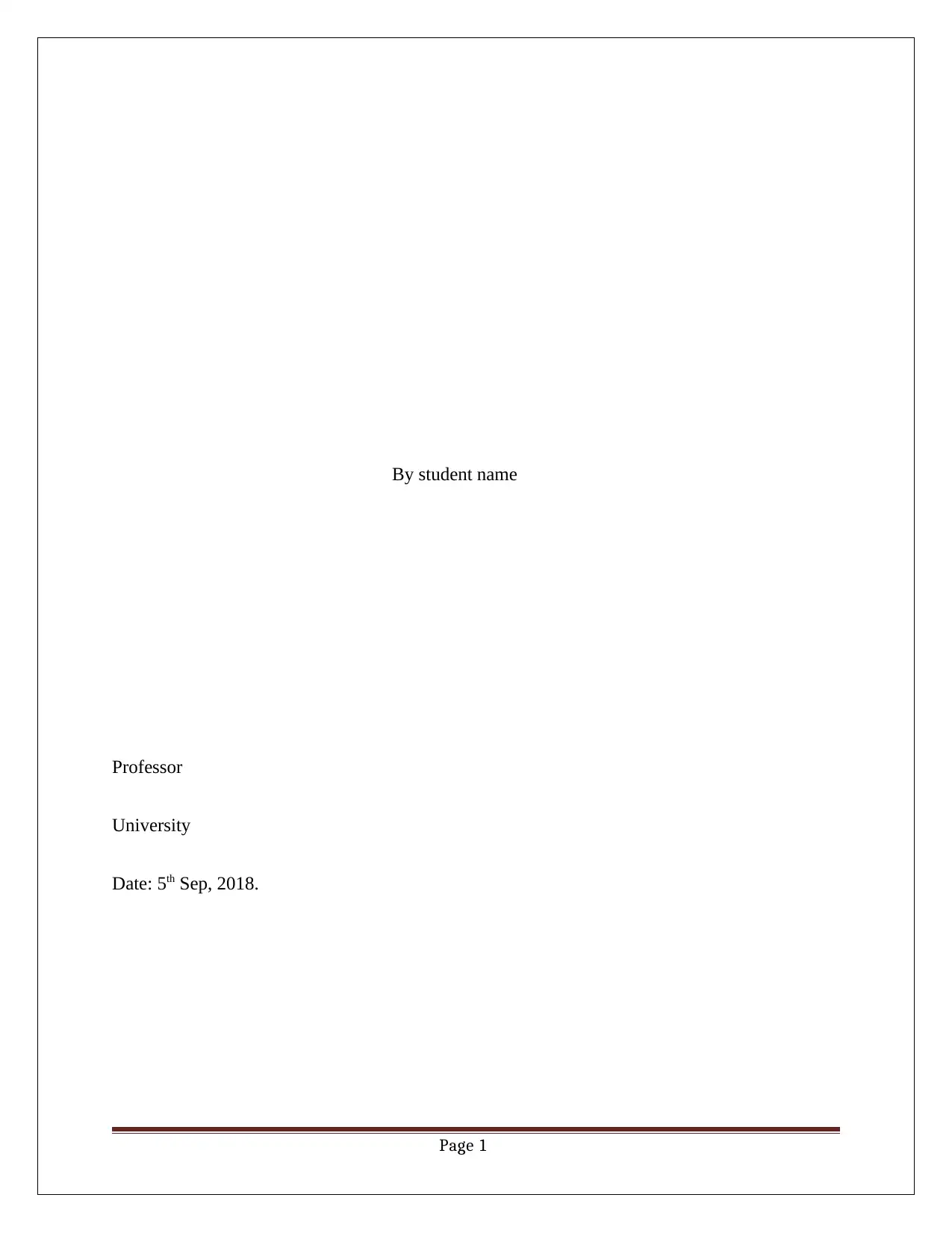
By student name
Professor
University
Date: 5th Sep, 2018.
Page 1
Professor
University
Date: 5th Sep, 2018.
Page 1
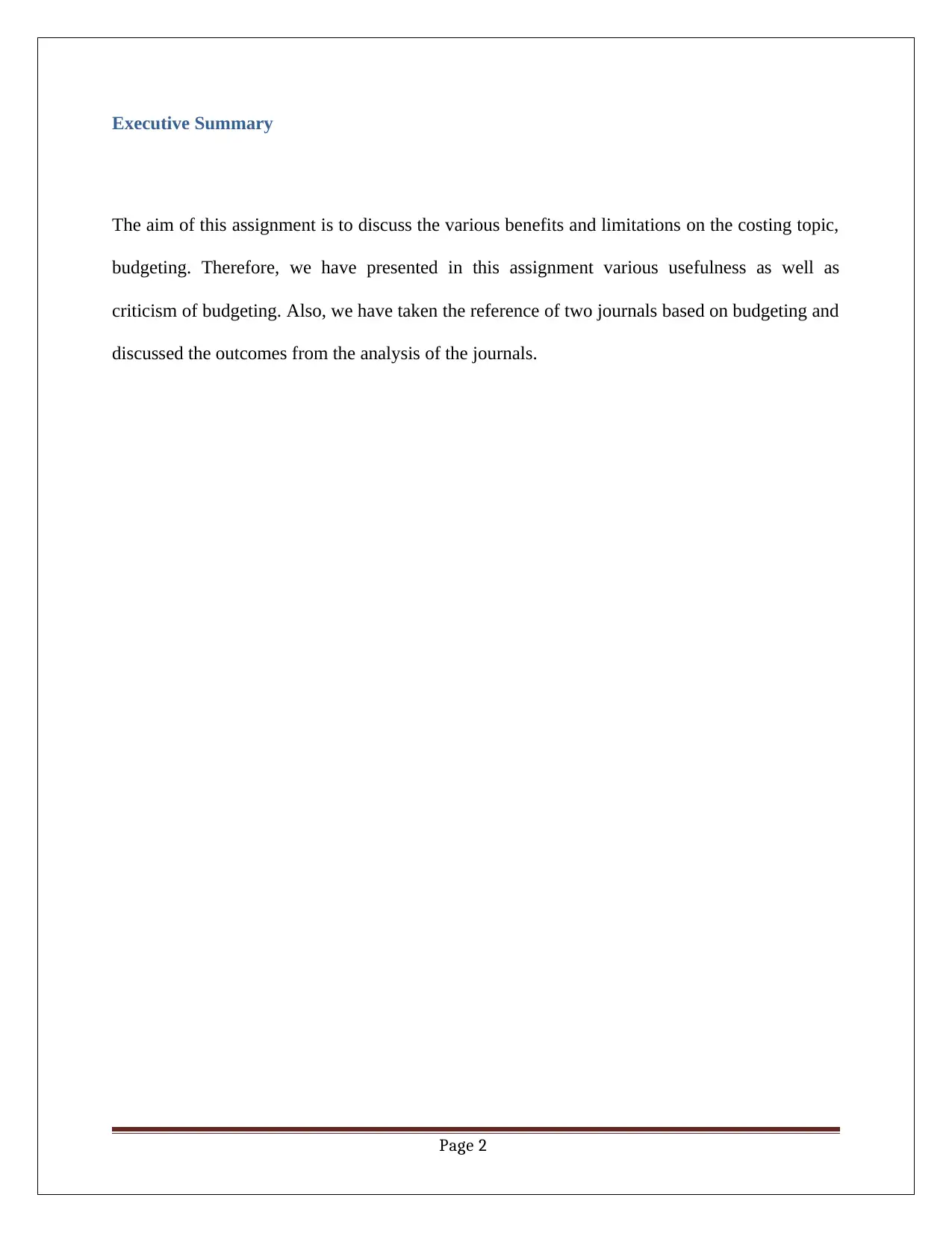
Executive Summary
The aim of this assignment is to discuss the various benefits and limitations on the costing topic,
budgeting. Therefore, we have presented in this assignment various usefulness as well as
criticism of budgeting. Also, we have taken the reference of two journals based on budgeting and
discussed the outcomes from the analysis of the journals.
Page 2
The aim of this assignment is to discuss the various benefits and limitations on the costing topic,
budgeting. Therefore, we have presented in this assignment various usefulness as well as
criticism of budgeting. Also, we have taken the reference of two journals based on budgeting and
discussed the outcomes from the analysis of the journals.
Page 2
⊘ This is a preview!⊘
Do you want full access?
Subscribe today to unlock all pages.

Trusted by 1+ million students worldwide
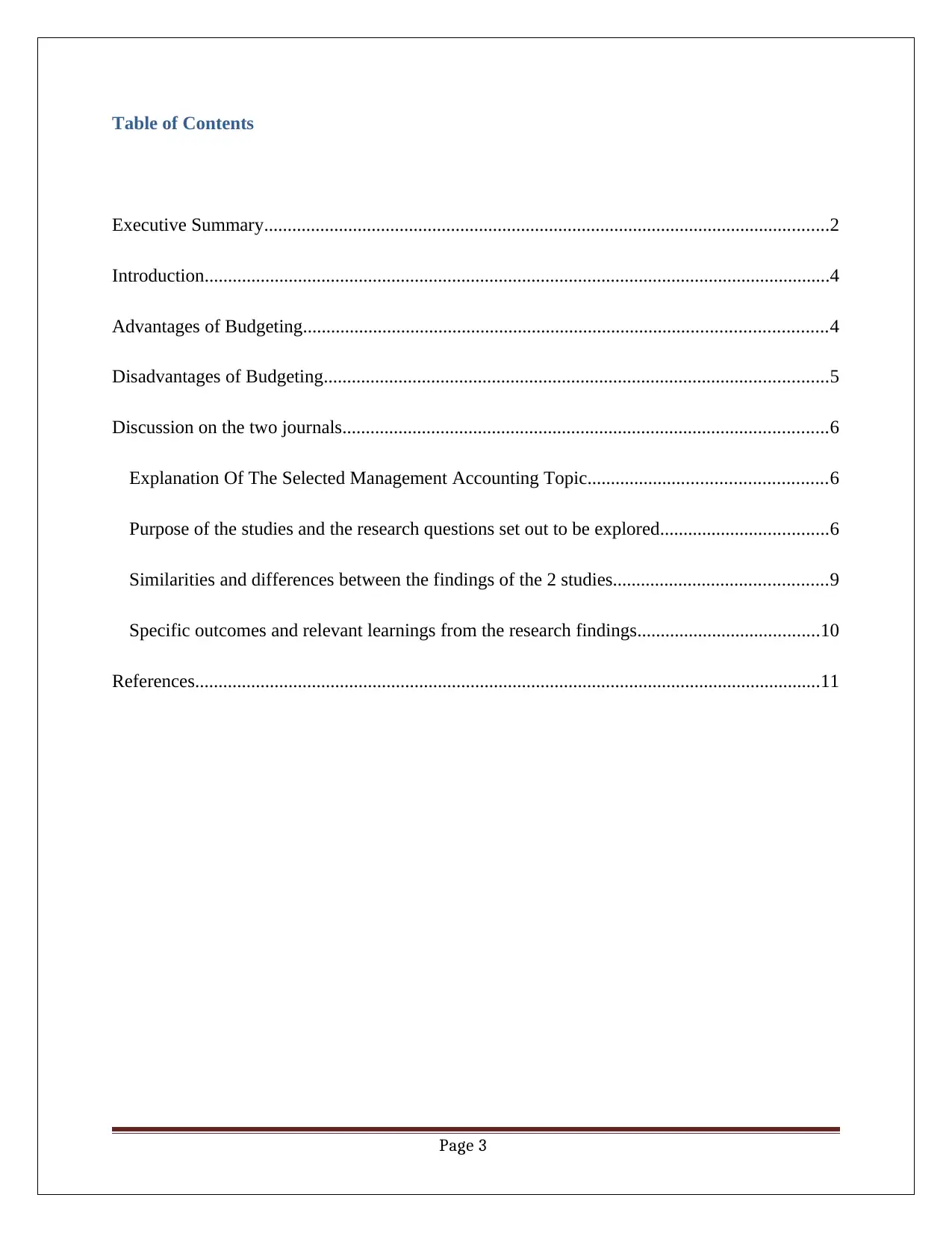
Table of Contents
Executive Summary.........................................................................................................................2
Introduction......................................................................................................................................4
Advantages of Budgeting................................................................................................................4
Disadvantages of Budgeting............................................................................................................5
Discussion on the two journals........................................................................................................6
Explanation Of The Selected Management Accounting Topic...................................................6
Purpose of the studies and the research questions set out to be explored....................................6
Similarities and differences between the findings of the 2 studies..............................................9
Specific outcomes and relevant learnings from the research findings.......................................10
References......................................................................................................................................11
Page 3
Executive Summary.........................................................................................................................2
Introduction......................................................................................................................................4
Advantages of Budgeting................................................................................................................4
Disadvantages of Budgeting............................................................................................................5
Discussion on the two journals........................................................................................................6
Explanation Of The Selected Management Accounting Topic...................................................6
Purpose of the studies and the research questions set out to be explored....................................6
Similarities and differences between the findings of the 2 studies..............................................9
Specific outcomes and relevant learnings from the research findings.......................................10
References......................................................................................................................................11
Page 3
Paraphrase This Document
Need a fresh take? Get an instant paraphrase of this document with our AI Paraphraser
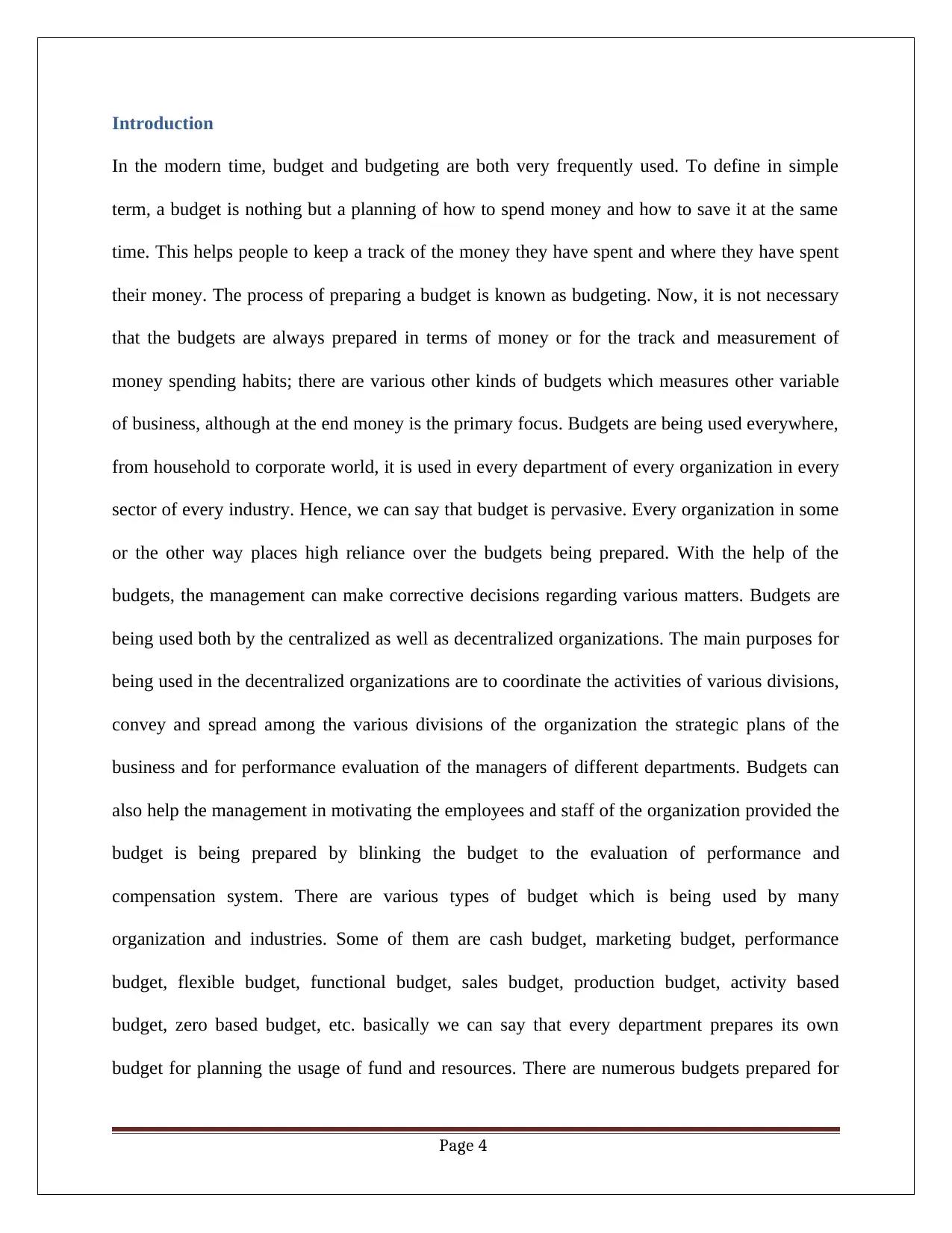
Introduction
In the modern time, budget and budgeting are both very frequently used. To define in simple
term, a budget is nothing but a planning of how to spend money and how to save it at the same
time. This helps people to keep a track of the money they have spent and where they have spent
their money. The process of preparing a budget is known as budgeting. Now, it is not necessary
that the budgets are always prepared in terms of money or for the track and measurement of
money spending habits; there are various other kinds of budgets which measures other variable
of business, although at the end money is the primary focus. Budgets are being used everywhere,
from household to corporate world, it is used in every department of every organization in every
sector of every industry. Hence, we can say that budget is pervasive. Every organization in some
or the other way places high reliance over the budgets being prepared. With the help of the
budgets, the management can make corrective decisions regarding various matters. Budgets are
being used both by the centralized as well as decentralized organizations. The main purposes for
being used in the decentralized organizations are to coordinate the activities of various divisions,
convey and spread among the various divisions of the organization the strategic plans of the
business and for performance evaluation of the managers of different departments. Budgets can
also help the management in motivating the employees and staff of the organization provided the
budget is being prepared by blinking the budget to the evaluation of performance and
compensation system. There are various types of budget which is being used by many
organization and industries. Some of them are cash budget, marketing budget, performance
budget, flexible budget, functional budget, sales budget, production budget, activity based
budget, zero based budget, etc. basically we can say that every department prepares its own
budget for planning the usage of fund and resources. There are numerous budgets prepared for
Page 4
In the modern time, budget and budgeting are both very frequently used. To define in simple
term, a budget is nothing but a planning of how to spend money and how to save it at the same
time. This helps people to keep a track of the money they have spent and where they have spent
their money. The process of preparing a budget is known as budgeting. Now, it is not necessary
that the budgets are always prepared in terms of money or for the track and measurement of
money spending habits; there are various other kinds of budgets which measures other variable
of business, although at the end money is the primary focus. Budgets are being used everywhere,
from household to corporate world, it is used in every department of every organization in every
sector of every industry. Hence, we can say that budget is pervasive. Every organization in some
or the other way places high reliance over the budgets being prepared. With the help of the
budgets, the management can make corrective decisions regarding various matters. Budgets are
being used both by the centralized as well as decentralized organizations. The main purposes for
being used in the decentralized organizations are to coordinate the activities of various divisions,
convey and spread among the various divisions of the organization the strategic plans of the
business and for performance evaluation of the managers of different departments. Budgets can
also help the management in motivating the employees and staff of the organization provided the
budget is being prepared by blinking the budget to the evaluation of performance and
compensation system. There are various types of budget which is being used by many
organization and industries. Some of them are cash budget, marketing budget, performance
budget, flexible budget, functional budget, sales budget, production budget, activity based
budget, zero based budget, etc. basically we can say that every department prepares its own
budget for planning the usage of fund and resources. There are numerous budgets prepared for
Page 4
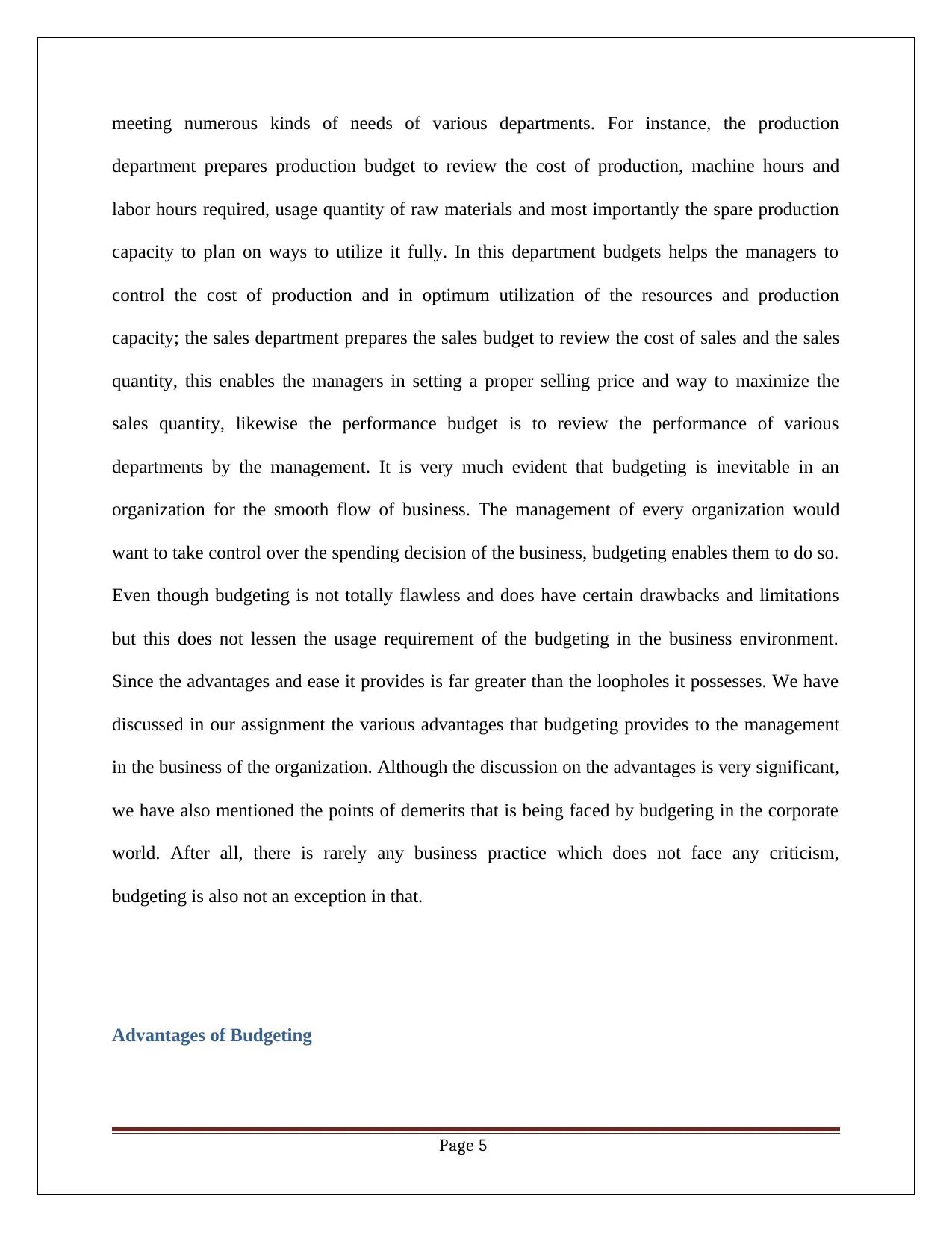
meeting numerous kinds of needs of various departments. For instance, the production
department prepares production budget to review the cost of production, machine hours and
labor hours required, usage quantity of raw materials and most importantly the spare production
capacity to plan on ways to utilize it fully. In this department budgets helps the managers to
control the cost of production and in optimum utilization of the resources and production
capacity; the sales department prepares the sales budget to review the cost of sales and the sales
quantity, this enables the managers in setting a proper selling price and way to maximize the
sales quantity, likewise the performance budget is to review the performance of various
departments by the management. It is very much evident that budgeting is inevitable in an
organization for the smooth flow of business. The management of every organization would
want to take control over the spending decision of the business, budgeting enables them to do so.
Even though budgeting is not totally flawless and does have certain drawbacks and limitations
but this does not lessen the usage requirement of the budgeting in the business environment.
Since the advantages and ease it provides is far greater than the loopholes it possesses. We have
discussed in our assignment the various advantages that budgeting provides to the management
in the business of the organization. Although the discussion on the advantages is very significant,
we have also mentioned the points of demerits that is being faced by budgeting in the corporate
world. After all, there is rarely any business practice which does not face any criticism,
budgeting is also not an exception in that.
Advantages of Budgeting
Page 5
department prepares production budget to review the cost of production, machine hours and
labor hours required, usage quantity of raw materials and most importantly the spare production
capacity to plan on ways to utilize it fully. In this department budgets helps the managers to
control the cost of production and in optimum utilization of the resources and production
capacity; the sales department prepares the sales budget to review the cost of sales and the sales
quantity, this enables the managers in setting a proper selling price and way to maximize the
sales quantity, likewise the performance budget is to review the performance of various
departments by the management. It is very much evident that budgeting is inevitable in an
organization for the smooth flow of business. The management of every organization would
want to take control over the spending decision of the business, budgeting enables them to do so.
Even though budgeting is not totally flawless and does have certain drawbacks and limitations
but this does not lessen the usage requirement of the budgeting in the business environment.
Since the advantages and ease it provides is far greater than the loopholes it possesses. We have
discussed in our assignment the various advantages that budgeting provides to the management
in the business of the organization. Although the discussion on the advantages is very significant,
we have also mentioned the points of demerits that is being faced by budgeting in the corporate
world. After all, there is rarely any business practice which does not face any criticism,
budgeting is also not an exception in that.
Advantages of Budgeting
Page 5
⊘ This is a preview!⊘
Do you want full access?
Subscribe today to unlock all pages.

Trusted by 1+ million students worldwide
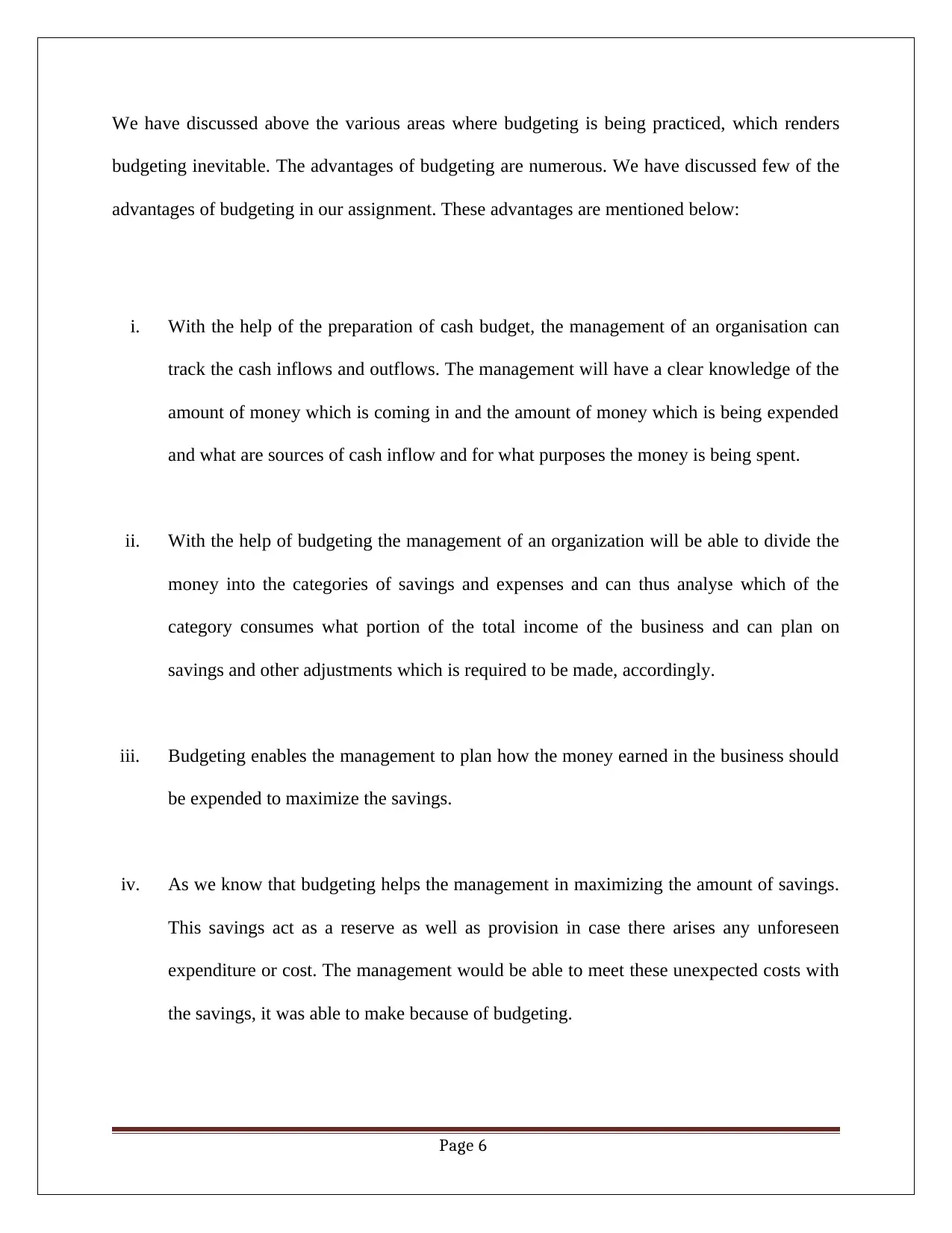
We have discussed above the various areas where budgeting is being practiced, which renders
budgeting inevitable. The advantages of budgeting are numerous. We have discussed few of the
advantages of budgeting in our assignment. These advantages are mentioned below:
i. With the help of the preparation of cash budget, the management of an organisation can
track the cash inflows and outflows. The management will have a clear knowledge of the
amount of money which is coming in and the amount of money which is being expended
and what are sources of cash inflow and for what purposes the money is being spent.
ii. With the help of budgeting the management of an organization will be able to divide the
money into the categories of savings and expenses and can thus analyse which of the
category consumes what portion of the total income of the business and can plan on
savings and other adjustments which is required to be made, accordingly.
iii. Budgeting enables the management to plan how the money earned in the business should
be expended to maximize the savings.
iv. As we know that budgeting helps the management in maximizing the amount of savings.
This savings act as a reserve as well as provision in case there arises any unforeseen
expenditure or cost. The management would be able to meet these unexpected costs with
the savings, it was able to make because of budgeting.
Page 6
budgeting inevitable. The advantages of budgeting are numerous. We have discussed few of the
advantages of budgeting in our assignment. These advantages are mentioned below:
i. With the help of the preparation of cash budget, the management of an organisation can
track the cash inflows and outflows. The management will have a clear knowledge of the
amount of money which is coming in and the amount of money which is being expended
and what are sources of cash inflow and for what purposes the money is being spent.
ii. With the help of budgeting the management of an organization will be able to divide the
money into the categories of savings and expenses and can thus analyse which of the
category consumes what portion of the total income of the business and can plan on
savings and other adjustments which is required to be made, accordingly.
iii. Budgeting enables the management to plan how the money earned in the business should
be expended to maximize the savings.
iv. As we know that budgeting helps the management in maximizing the amount of savings.
This savings act as a reserve as well as provision in case there arises any unforeseen
expenditure or cost. The management would be able to meet these unexpected costs with
the savings, it was able to make because of budgeting.
Page 6
Paraphrase This Document
Need a fresh take? Get an instant paraphrase of this document with our AI Paraphraser
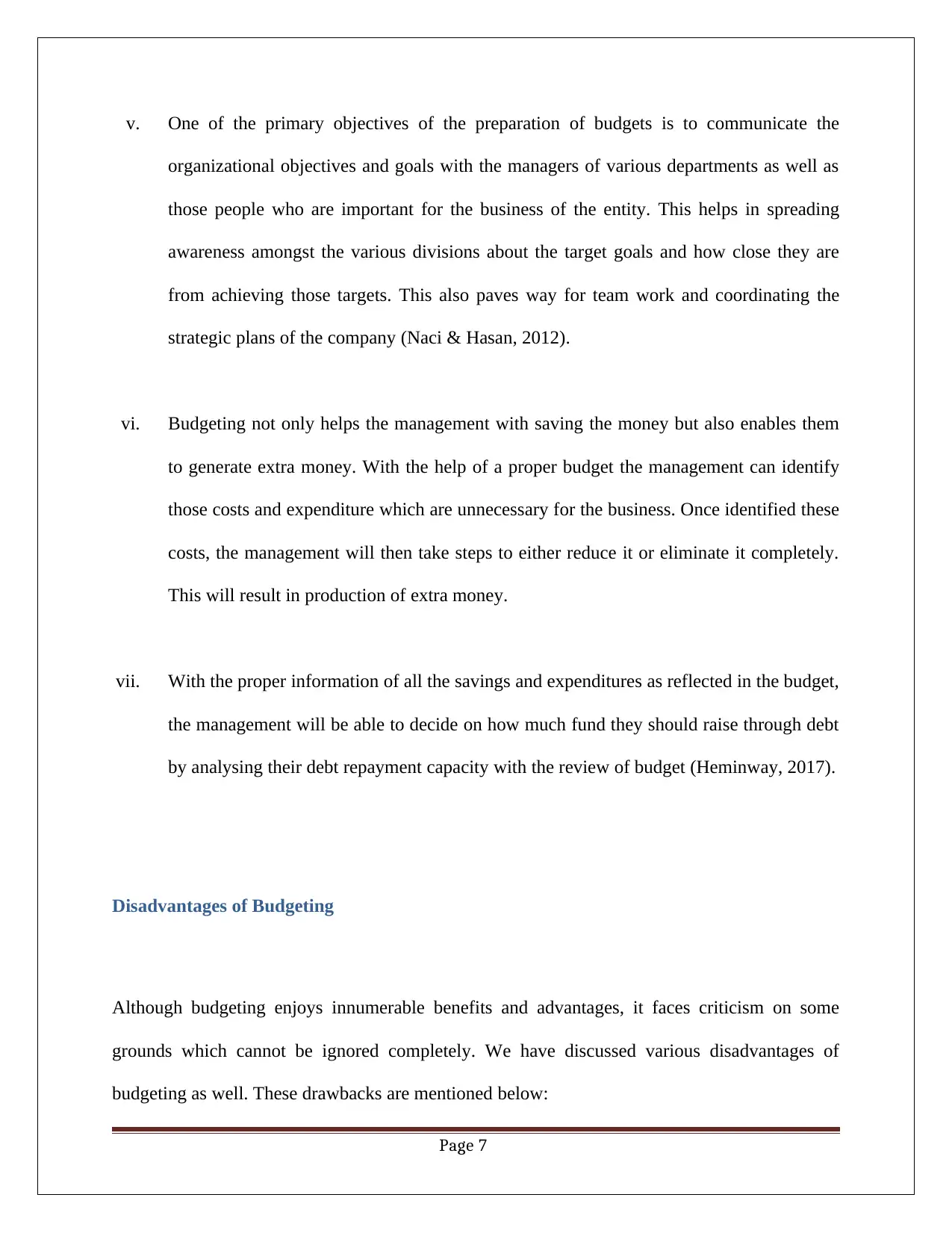
v. One of the primary objectives of the preparation of budgets is to communicate the
organizational objectives and goals with the managers of various departments as well as
those people who are important for the business of the entity. This helps in spreading
awareness amongst the various divisions about the target goals and how close they are
from achieving those targets. This also paves way for team work and coordinating the
strategic plans of the company (Naci & Hasan, 2012).
vi. Budgeting not only helps the management with saving the money but also enables them
to generate extra money. With the help of a proper budget the management can identify
those costs and expenditure which are unnecessary for the business. Once identified these
costs, the management will then take steps to either reduce it or eliminate it completely.
This will result in production of extra money.
vii. With the proper information of all the savings and expenditures as reflected in the budget,
the management will be able to decide on how much fund they should raise through debt
by analysing their debt repayment capacity with the review of budget (Heminway, 2017).
Disadvantages of Budgeting
Although budgeting enjoys innumerable benefits and advantages, it faces criticism on some
grounds which cannot be ignored completely. We have discussed various disadvantages of
budgeting as well. These drawbacks are mentioned below:
Page 7
organizational objectives and goals with the managers of various departments as well as
those people who are important for the business of the entity. This helps in spreading
awareness amongst the various divisions about the target goals and how close they are
from achieving those targets. This also paves way for team work and coordinating the
strategic plans of the company (Naci & Hasan, 2012).
vi. Budgeting not only helps the management with saving the money but also enables them
to generate extra money. With the help of a proper budget the management can identify
those costs and expenditure which are unnecessary for the business. Once identified these
costs, the management will then take steps to either reduce it or eliminate it completely.
This will result in production of extra money.
vii. With the proper information of all the savings and expenditures as reflected in the budget,
the management will be able to decide on how much fund they should raise through debt
by analysing their debt repayment capacity with the review of budget (Heminway, 2017).
Disadvantages of Budgeting
Although budgeting enjoys innumerable benefits and advantages, it faces criticism on some
grounds which cannot be ignored completely. We have discussed various disadvantages of
budgeting as well. These drawbacks are mentioned below:
Page 7
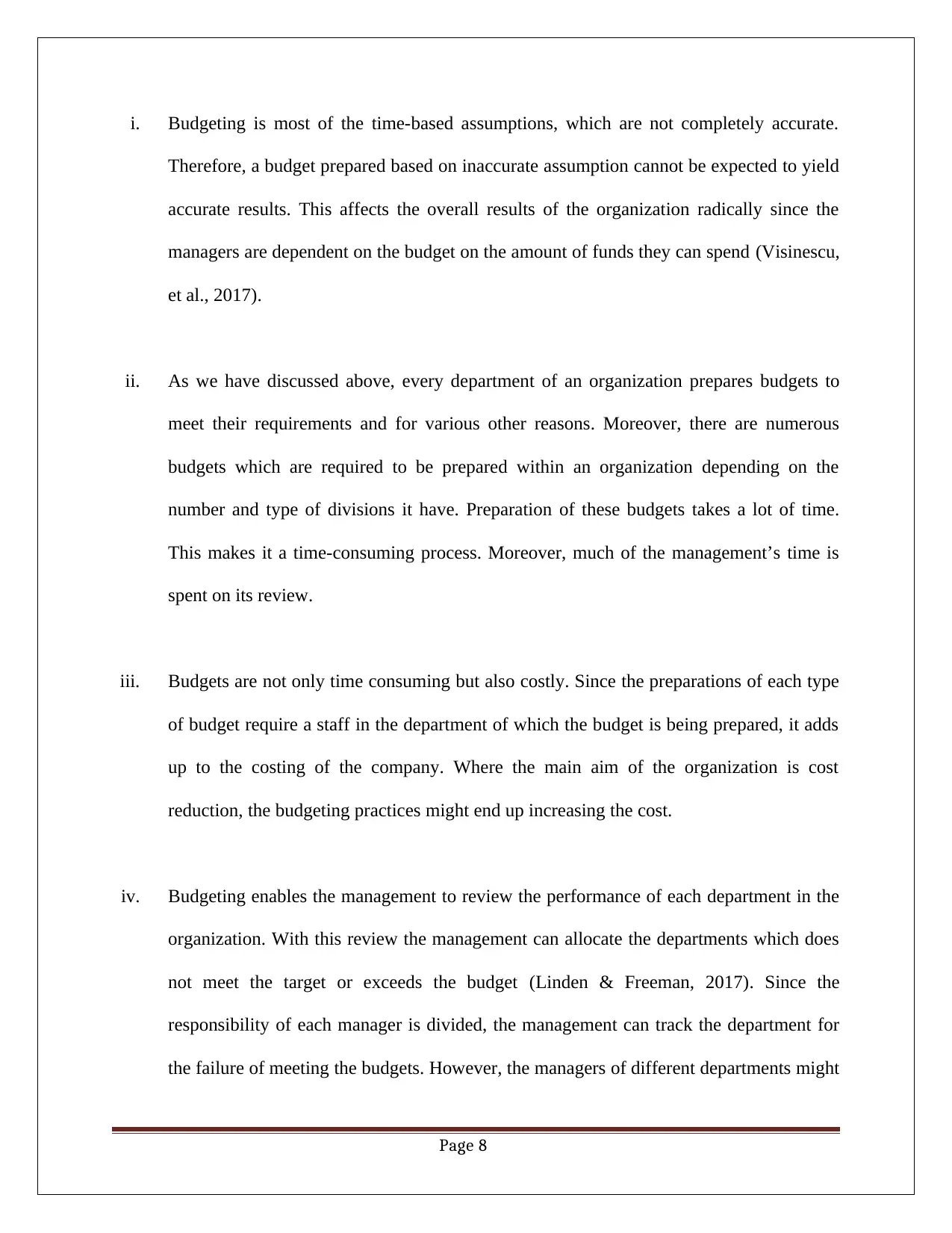
i. Budgeting is most of the time-based assumptions, which are not completely accurate.
Therefore, a budget prepared based on inaccurate assumption cannot be expected to yield
accurate results. This affects the overall results of the organization radically since the
managers are dependent on the budget on the amount of funds they can spend (Visinescu,
et al., 2017).
ii. As we have discussed above, every department of an organization prepares budgets to
meet their requirements and for various other reasons. Moreover, there are numerous
budgets which are required to be prepared within an organization depending on the
number and type of divisions it have. Preparation of these budgets takes a lot of time.
This makes it a time-consuming process. Moreover, much of the management’s time is
spent on its review.
iii. Budgets are not only time consuming but also costly. Since the preparations of each type
of budget require a staff in the department of which the budget is being prepared, it adds
up to the costing of the company. Where the main aim of the organization is cost
reduction, the budgeting practices might end up increasing the cost.
iv. Budgeting enables the management to review the performance of each department in the
organization. With this review the management can allocate the departments which does
not meet the target or exceeds the budget (Linden & Freeman, 2017). Since the
responsibility of each manager is divided, the management can track the department for
the failure of meeting the budgets. However, the managers of different departments might
Page 8
Therefore, a budget prepared based on inaccurate assumption cannot be expected to yield
accurate results. This affects the overall results of the organization radically since the
managers are dependent on the budget on the amount of funds they can spend (Visinescu,
et al., 2017).
ii. As we have discussed above, every department of an organization prepares budgets to
meet their requirements and for various other reasons. Moreover, there are numerous
budgets which are required to be prepared within an organization depending on the
number and type of divisions it have. Preparation of these budgets takes a lot of time.
This makes it a time-consuming process. Moreover, much of the management’s time is
spent on its review.
iii. Budgets are not only time consuming but also costly. Since the preparations of each type
of budget require a staff in the department of which the budget is being prepared, it adds
up to the costing of the company. Where the main aim of the organization is cost
reduction, the budgeting practices might end up increasing the cost.
iv. Budgeting enables the management to review the performance of each department in the
organization. With this review the management can allocate the departments which does
not meet the target or exceeds the budget (Linden & Freeman, 2017). Since the
responsibility of each manager is divided, the management can track the department for
the failure of meeting the budgets. However, the managers of different departments might
Page 8
⊘ This is a preview!⊘
Do you want full access?
Subscribe today to unlock all pages.

Trusted by 1+ million students worldwide
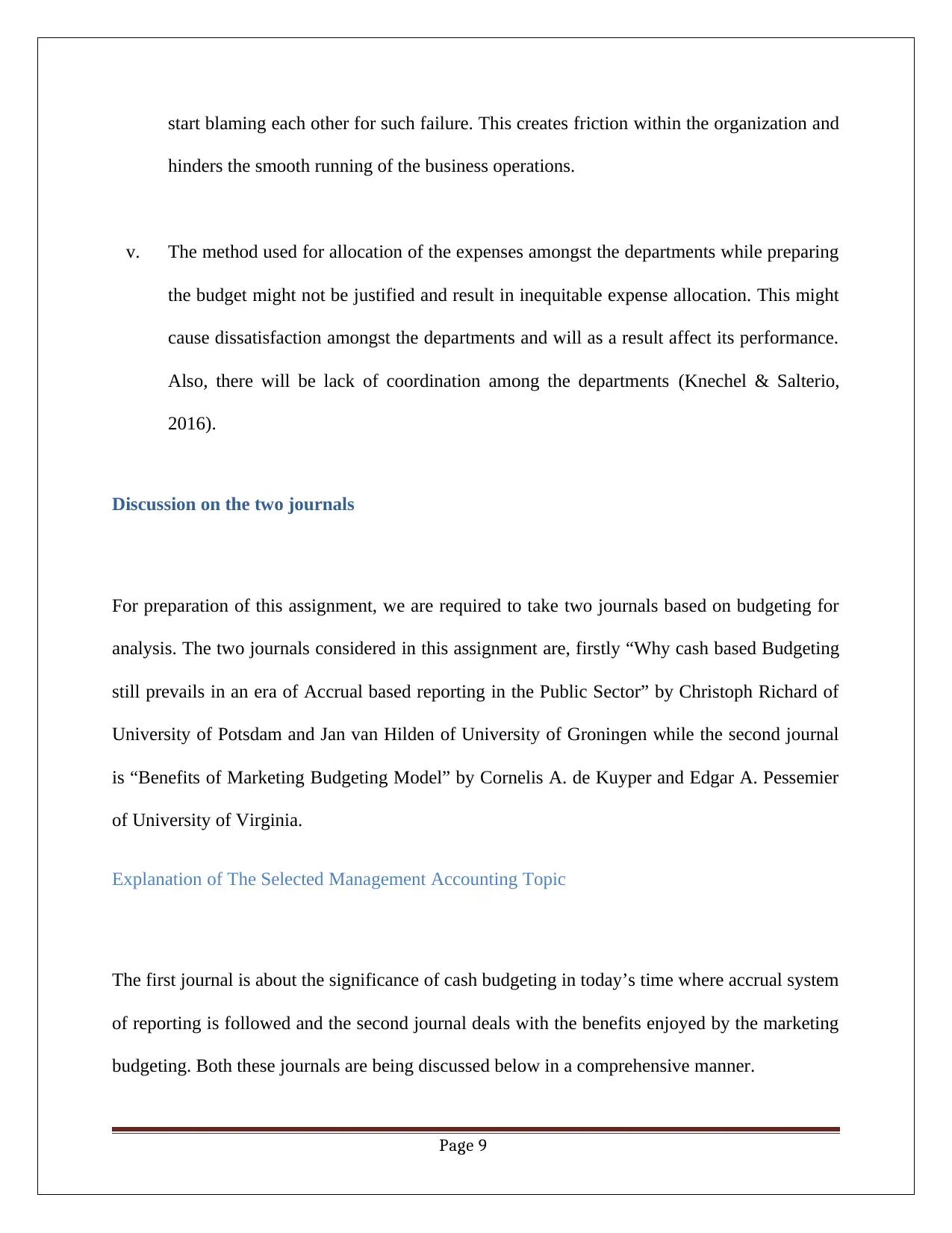
start blaming each other for such failure. This creates friction within the organization and
hinders the smooth running of the business operations.
v. The method used for allocation of the expenses amongst the departments while preparing
the budget might not be justified and result in inequitable expense allocation. This might
cause dissatisfaction amongst the departments and will as a result affect its performance.
Also, there will be lack of coordination among the departments (Knechel & Salterio,
2016).
Discussion on the two journals
For preparation of this assignment, we are required to take two journals based on budgeting for
analysis. The two journals considered in this assignment are, firstly “Why cash based Budgeting
still prevails in an era of Accrual based reporting in the Public Sector” by Christoph Richard of
University of Potsdam and Jan van Hilden of University of Groningen while the second journal
is “Benefits of Marketing Budgeting Model” by Cornelis A. de Kuyper and Edgar A. Pessemier
of University of Virginia.
Explanation of The Selected Management Accounting Topic
The first journal is about the significance of cash budgeting in today’s time where accrual system
of reporting is followed and the second journal deals with the benefits enjoyed by the marketing
budgeting. Both these journals are being discussed below in a comprehensive manner.
Page 9
hinders the smooth running of the business operations.
v. The method used for allocation of the expenses amongst the departments while preparing
the budget might not be justified and result in inequitable expense allocation. This might
cause dissatisfaction amongst the departments and will as a result affect its performance.
Also, there will be lack of coordination among the departments (Knechel & Salterio,
2016).
Discussion on the two journals
For preparation of this assignment, we are required to take two journals based on budgeting for
analysis. The two journals considered in this assignment are, firstly “Why cash based Budgeting
still prevails in an era of Accrual based reporting in the Public Sector” by Christoph Richard of
University of Potsdam and Jan van Hilden of University of Groningen while the second journal
is “Benefits of Marketing Budgeting Model” by Cornelis A. de Kuyper and Edgar A. Pessemier
of University of Virginia.
Explanation of The Selected Management Accounting Topic
The first journal is about the significance of cash budgeting in today’s time where accrual system
of reporting is followed and the second journal deals with the benefits enjoyed by the marketing
budgeting. Both these journals are being discussed below in a comprehensive manner.
Page 9
Paraphrase This Document
Need a fresh take? Get an instant paraphrase of this document with our AI Paraphraser
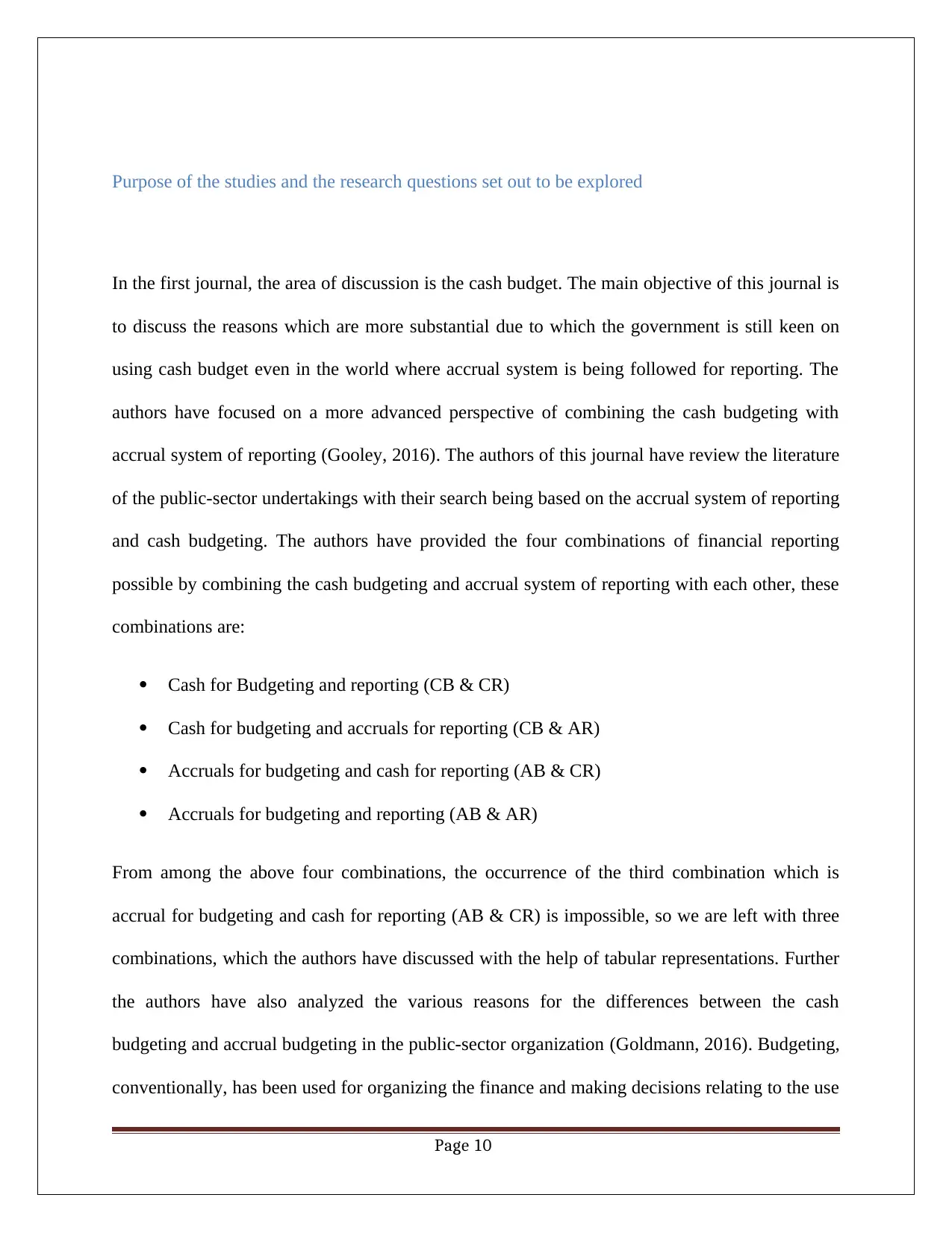
Purpose of the studies and the research questions set out to be explored
In the first journal, the area of discussion is the cash budget. The main objective of this journal is
to discuss the reasons which are more substantial due to which the government is still keen on
using cash budget even in the world where accrual system is being followed for reporting. The
authors have focused on a more advanced perspective of combining the cash budgeting with
accrual system of reporting (Gooley, 2016). The authors of this journal have review the literature
of the public-sector undertakings with their search being based on the accrual system of reporting
and cash budgeting. The authors have provided the four combinations of financial reporting
possible by combining the cash budgeting and accrual system of reporting with each other, these
combinations are:
Cash for Budgeting and reporting (CB & CR)
Cash for budgeting and accruals for reporting (CB & AR)
Accruals for budgeting and cash for reporting (AB & CR)
Accruals for budgeting and reporting (AB & AR)
From among the above four combinations, the occurrence of the third combination which is
accrual for budgeting and cash for reporting (AB & CR) is impossible, so we are left with three
combinations, which the authors have discussed with the help of tabular representations. Further
the authors have also analyzed the various reasons for the differences between the cash
budgeting and accrual budgeting in the public-sector organization (Goldmann, 2016). Budgeting,
conventionally, has been used for organizing the finance and making decisions relating to the use
Page 10
In the first journal, the area of discussion is the cash budget. The main objective of this journal is
to discuss the reasons which are more substantial due to which the government is still keen on
using cash budget even in the world where accrual system is being followed for reporting. The
authors have focused on a more advanced perspective of combining the cash budgeting with
accrual system of reporting (Gooley, 2016). The authors of this journal have review the literature
of the public-sector undertakings with their search being based on the accrual system of reporting
and cash budgeting. The authors have provided the four combinations of financial reporting
possible by combining the cash budgeting and accrual system of reporting with each other, these
combinations are:
Cash for Budgeting and reporting (CB & CR)
Cash for budgeting and accruals for reporting (CB & AR)
Accruals for budgeting and cash for reporting (AB & CR)
Accruals for budgeting and reporting (AB & AR)
From among the above four combinations, the occurrence of the third combination which is
accrual for budgeting and cash for reporting (AB & CR) is impossible, so we are left with three
combinations, which the authors have discussed with the help of tabular representations. Further
the authors have also analyzed the various reasons for the differences between the cash
budgeting and accrual budgeting in the public-sector organization (Goldmann, 2016). Budgeting,
conventionally, has been used for organizing the finance and making decisions relating to the use
Page 10
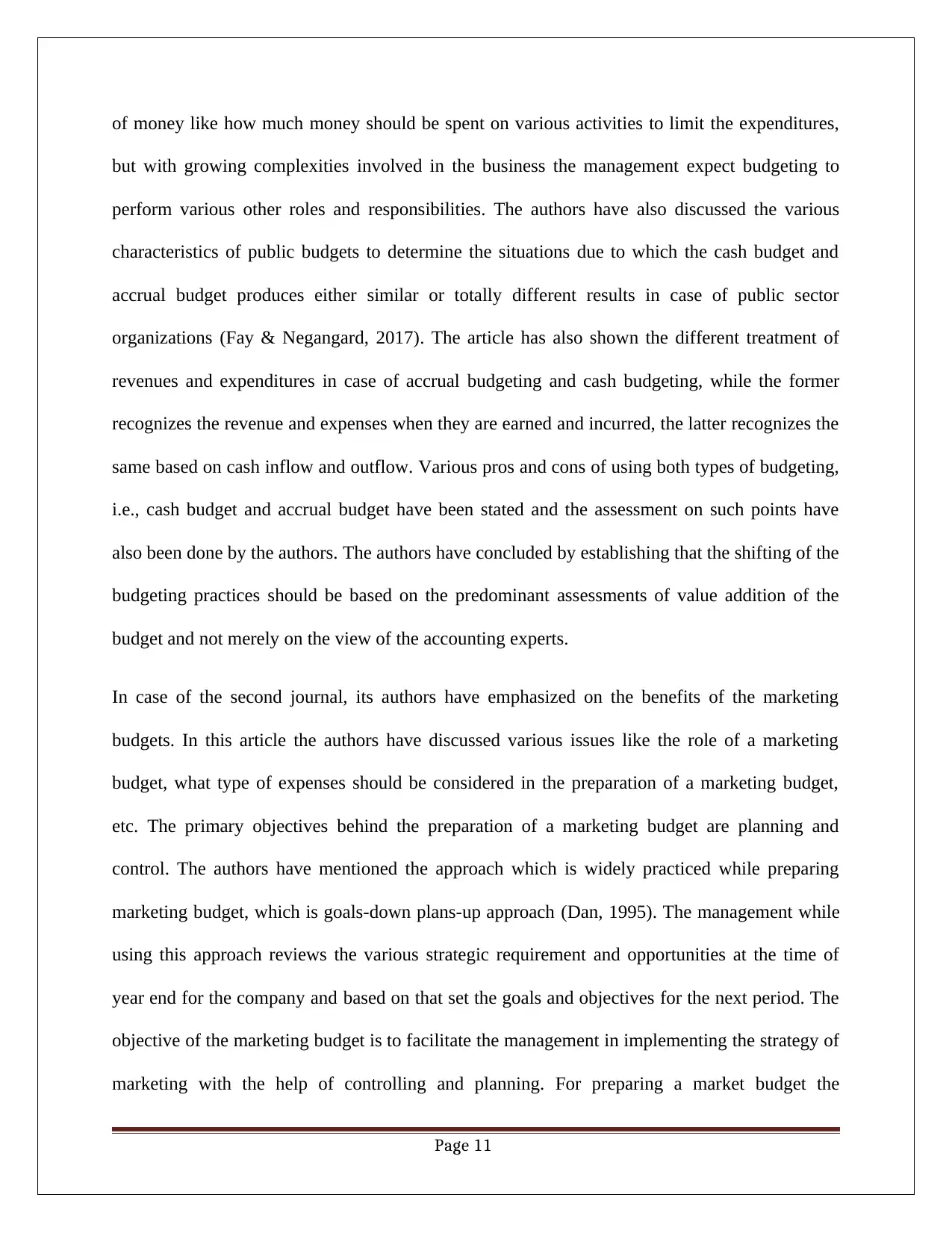
of money like how much money should be spent on various activities to limit the expenditures,
but with growing complexities involved in the business the management expect budgeting to
perform various other roles and responsibilities. The authors have also discussed the various
characteristics of public budgets to determine the situations due to which the cash budget and
accrual budget produces either similar or totally different results in case of public sector
organizations (Fay & Negangard, 2017). The article has also shown the different treatment of
revenues and expenditures in case of accrual budgeting and cash budgeting, while the former
recognizes the revenue and expenses when they are earned and incurred, the latter recognizes the
same based on cash inflow and outflow. Various pros and cons of using both types of budgeting,
i.e., cash budget and accrual budget have been stated and the assessment on such points have
also been done by the authors. The authors have concluded by establishing that the shifting of the
budgeting practices should be based on the predominant assessments of value addition of the
budget and not merely on the view of the accounting experts.
In case of the second journal, its authors have emphasized on the benefits of the marketing
budgets. In this article the authors have discussed various issues like the role of a marketing
budget, what type of expenses should be considered in the preparation of a marketing budget,
etc. The primary objectives behind the preparation of a marketing budget are planning and
control. The authors have mentioned the approach which is widely practiced while preparing
marketing budget, which is goals-down plans-up approach (Dan, 1995). The management while
using this approach reviews the various strategic requirement and opportunities at the time of
year end for the company and based on that set the goals and objectives for the next period. The
objective of the marketing budget is to facilitate the management in implementing the strategy of
marketing with the help of controlling and planning. For preparing a market budget the
Page 11
but with growing complexities involved in the business the management expect budgeting to
perform various other roles and responsibilities. The authors have also discussed the various
characteristics of public budgets to determine the situations due to which the cash budget and
accrual budget produces either similar or totally different results in case of public sector
organizations (Fay & Negangard, 2017). The article has also shown the different treatment of
revenues and expenditures in case of accrual budgeting and cash budgeting, while the former
recognizes the revenue and expenses when they are earned and incurred, the latter recognizes the
same based on cash inflow and outflow. Various pros and cons of using both types of budgeting,
i.e., cash budget and accrual budget have been stated and the assessment on such points have
also been done by the authors. The authors have concluded by establishing that the shifting of the
budgeting practices should be based on the predominant assessments of value addition of the
budget and not merely on the view of the accounting experts.
In case of the second journal, its authors have emphasized on the benefits of the marketing
budgets. In this article the authors have discussed various issues like the role of a marketing
budget, what type of expenses should be considered in the preparation of a marketing budget,
etc. The primary objectives behind the preparation of a marketing budget are planning and
control. The authors have mentioned the approach which is widely practiced while preparing
marketing budget, which is goals-down plans-up approach (Dan, 1995). The management while
using this approach reviews the various strategic requirement and opportunities at the time of
year end for the company and based on that set the goals and objectives for the next period. The
objective of the marketing budget is to facilitate the management in implementing the strategy of
marketing with the help of controlling and planning. For preparing a market budget the
Page 11
⊘ This is a preview!⊘
Do you want full access?
Subscribe today to unlock all pages.

Trusted by 1+ million students worldwide
1 out of 19
Related Documents
Your All-in-One AI-Powered Toolkit for Academic Success.
+13062052269
info@desklib.com
Available 24*7 on WhatsApp / Email
![[object Object]](/_next/static/media/star-bottom.7253800d.svg)
Unlock your academic potential
Copyright © 2020–2025 A2Z Services. All Rights Reserved. Developed and managed by ZUCOL.





